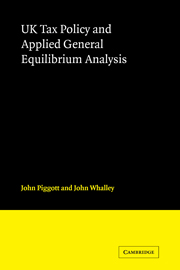Book contents
- Frontmatter
- Contents
- PREFACE
- ACKNOWLEDGEMENTS
- INTRODUCTION AND SUMMARY OF STUDY
- PART I The General Equilibrium Model of the UK – Structure, Data and Model Solution.
- PART II Empirical Analysis of the UK Tax/Subsidy System Using the General Equilibrium Model
- CHAPTER 7 Detailed Analysis of Central Case Model Experiment Involving Removal of Non-Savings/Non-Leisure Tax/Subsidy Distortion
- CHAPTER 8 Analysis of Structural Characteristics of the Tax/Subsidy System
- CHAPTER 9 Further Analysis of Tax/Subsidy Distortions
- SUMMARY AND CONCLUSIONS
- APPENDIX A Structure of the Basic Variant Model
- APPENDIX B Notes to Tables Appearing in Chapter 5
- APPENDIX C Notes on Programming and Computation
- BIBLIOGRAPHY
CHAPTER 7 - Detailed Analysis of Central Case Model Experiment Involving Removal of Non-Savings/Non-Leisure Tax/Subsidy Distortion
Published online by Cambridge University Press: 04 August 2010
- Frontmatter
- Contents
- PREFACE
- ACKNOWLEDGEMENTS
- INTRODUCTION AND SUMMARY OF STUDY
- PART I The General Equilibrium Model of the UK – Structure, Data and Model Solution.
- PART II Empirical Analysis of the UK Tax/Subsidy System Using the General Equilibrium Model
- CHAPTER 7 Detailed Analysis of Central Case Model Experiment Involving Removal of Non-Savings/Non-Leisure Tax/Subsidy Distortion
- CHAPTER 8 Analysis of Structural Characteristics of the Tax/Subsidy System
- CHAPTER 9 Further Analysis of Tax/Subsidy Distortions
- SUMMARY AND CONCLUSIONS
- APPENDIX A Structure of the Basic Variant Model
- APPENDIX B Notes to Tables Appearing in Chapter 5
- APPENDIX C Notes on Programming and Computation
- BIBLIOGRAPHY
Summary
Introduction
This chapter presents results from our analysis of the static industry and commodity distortions in the UK tax/subsidy system using 1973 data. Distortions of labour supply, savings decisions, those attributable to a non-indexed tax system, and analysis involving public goods are all left until Chapter 9. In this chapter, we concentrate on one central counterfactual experiment from the model and explore the results in detail.
The characteristics of this central case are as follows:
1. Fixed factor static formulation. Aggregate factor supplies are fixed; household savings do not vary with the rate of return on capital. A single period static equilibrium is assumed in the presence of alternative policy regimes.
2. Equal yield tax replacement of all existing taxes and subsidies. All existing taxes and subsidies are abolished and replaced by a non-distorting yield preserving single rate sales tax. The size of the public sector is preserved in real terms. The replacement follows Musgrave's (1959) concept of “differential incidence”.
3. Terms of trade neutralizing surtax/subsidy. Because of the nature of the tax system and the trade elasticities used, terms of trade effects accompany tax changes in the model. UK trade elasticities are low, and since high effective tax rates apply to the production and sale of exports in the model, the tax system produces a terms of trade gain to the economy. Without a terms of trade neutralizing tax we find that the welfare gains to the UK are smaller than they would be with such a tax.
- Type
- Chapter
- Information
- UK Tax Policy and Applied General Equilibrium Analysis , pp. 184 - 229Publisher: Cambridge University PressPrint publication year: 1985



